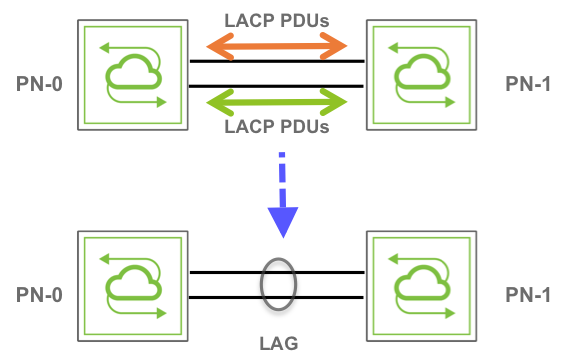
Understanding the Link Aggregation Control Protocol (LACP)
The IEEE 802.3ad Link Aggregation Control Protocol (LACP) supports the automatic creation of Ethernet LAGs by exchanging special LACP frames (called LACPDUs) down all the links that have the protocol enabled. If it finds an LACP-capable neighbor device (peer) on the other end of the links, it will negotiate the dynamic creation of a LAG comprising all the compatible links (only full-duplex point-to-point Ethernet links running at the same speed can be matched and grouped together).

Figure 7-2 - Link Aggregation Control Protocol (LACP)
The LACP dynamic negotiation can be configured in one of two modes: active or passive.
In active mode LACP always (unconditionally) sends frames along the configured links that are intended to be bundled together. In passive mode, instead, LACP does not initiate a conversation/negotiation until it hears from the peer (this is typically the default configuration). Hence, for the negotiation to start at least one of the peers needs to be switched to active mode by the network administrator.
Once the negotiation is complete and the configured number of ports is aggregated, LACP periodically transmits keepalive frames over a LAG to verify connectivity of each link member and to react (i.e., trigger a link failover) in case of detection of a malfunction. LACP can be configured with a slow or fast lacp-timeout value (90s vs 3s) to react more gracefully or more promptly to connectivity changes.
LACP therefore is very helpful with the function of creating and/or augmenting a LAG as it always performs the necessary validations of the added links (such as bidirectional connectivity).
The maximum number (N) of bundled ports in a LAG is typically (4 or) 8. On top of that a significant number of LAGs (L) may need to be provisioned in a large network design to achieve optimal scalability. Therefore, especially in complex deployments with many LAGs and several ports per LAG, the LACP dynamic function plays a really crucial role both in simplifying the port bundling process and in making sure that such process runs smoothly and error free over a large number of network entities (N x L).
In addition, in case of link failure, both LACP and the hardware algorithms will then make sure that the re-convergence/failover process is prompt and minimally impactful for the traffic. (On the other hand, static LAG configuration would not guarantee an equally easy and effective behavior in all possible scenarios.)
In summary, the LACP logic performs the following functions on the switch:
- Maintains configuration and port state information to control link aggregation.
- Exchanges configuration and connectivity information with other peer devices.
- Attaches or detaches ports from LAGs based on the exchanged configuration and state information.
LACP frames are always exchanged between neighboring ports when in active mode, whereas in passive mode frames are exchanged as long as the peer is active. This allows the network admin to leverage the automated LACP negotiation logic to control the LAG bring-up or bring-down process by simply configuring one side of a trunk.
Off mode is instead used to disable the LACP function on a trunk when for example the network admin wants to manage the trunk bring up process manually (however that prevents any dynamic negotiation and link verification).
Furthermore, LACP employs two priority values to determine which ports to aggregate into an active LAG. If for example a hardware limitation prevents all configured compatible ports from aggregating, then the priority values will be used by LACP to select which ports to add and which ports to keep in standby mode.
LAG members in standby mode don’t actively participate in traffic forwarding but can later be promoted to forwarding state to be used to replace a failed LAG member.
The LACP logic uses a system priority value, which is generated by the combination of the device MAC address with a user-configurable two-octet priority parameter. It also uses a port aggregation priority value, which is generated by the combination of the port number with a user-configurable two-octet priority parameter. Both priority values are used by LACP to dynamically select which port to aggregate in a bundle and which device (with higher priority) is entitled to that decision. The values for both user-configurable priority parameters can vary from 1 to 65535. Their default configuration is 32768.
Just as their member links, LAGs are point-to-point logical connections, so they can only be as resilient as the networking nodes that they interconnect. In other words, if either peer device at the end of the LAG fails, the entire LAG goes down.
Therefore, in order to further improve the network’s fault tolerance, it is of paramount importance to introduce multiple redundant traffic paths in the design (also known as multi-pathing).
This can be achieved in numerous ways at Layer 2 and/or at Layer 3. A very effective Layer 2 strategy to implement dual fully redundant paths with very fast traffic failover is to extend the capability of LAG across two distinct switches to create a virtual LAG device pair.
In Pluribus terminology this cross-chassis LAG capability is implemented with switch clusters.
